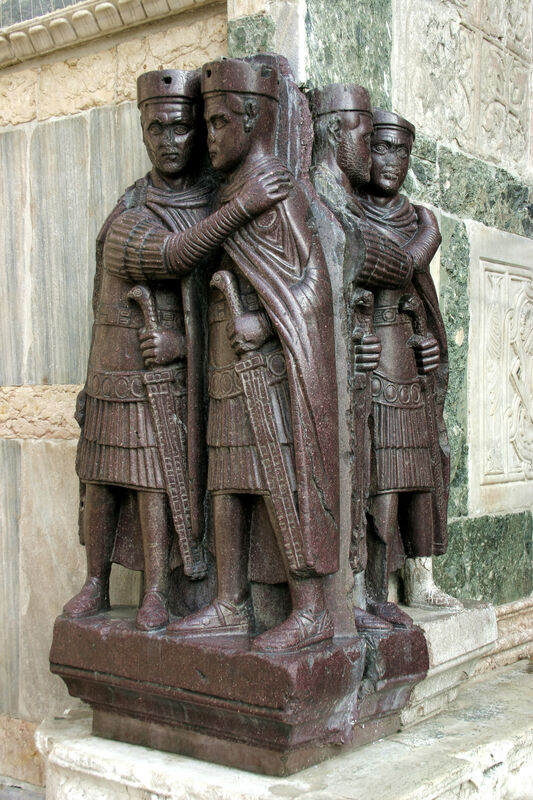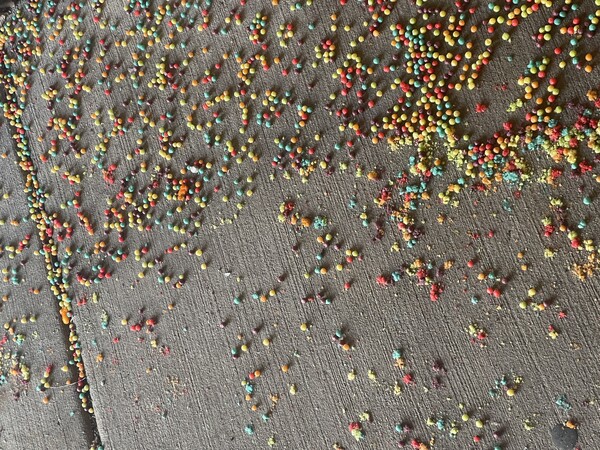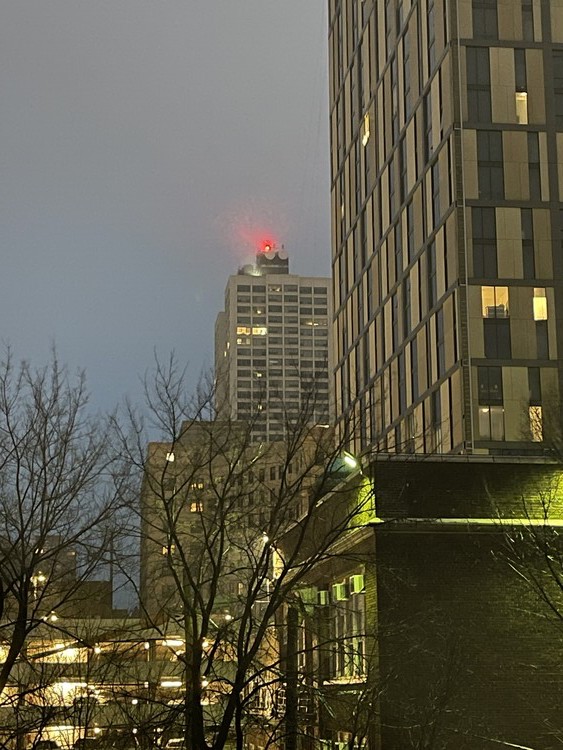
Mammatus Formations

Thunderclouds passing out of the area, east over Lake Michigan, yesterday. I believe these unusual extensions on the underside are a somewhat rare variant known as mammatus (it means what it sounds like), which often form at the tail end of thunderstorms when unstable air falls beneath the bottom layer of the cloud, creating the whispy outgrowths visible here.
cloudsChildren and the Feeling Computer
Sherry Turkle in The Second Self: Computers and the Human Spirit(1984) on her fieldwork about how children distinguish between humans and computers:
Emotion is the psychological quantity most frequently used to separate the human and the machine. But it is not the only one. David, twelve, a sophisticated programmer, used a concrete language to express a more nuanced set of qualities: “When there are computers who are just as smart as people, the computers will do a lot of the jobs, but there will still be things for the people to do. They will run the restaurants, taste the food, and they will be the oneswho will ove each other, have families and love each other. I guess they’ll still be the only ones who go to church. (62)
1984 was before the internet-driven tech boom, but I see its concepts anticipated in the child’s comments: computers are logical, people are emotional; what distinguishes people is their ability to feel and use the senses; people have bodily and spiritual needs, computers do not. If there is a master message in today’s commercial digital world, it is that computers do stuff so that human beings can do “more important things.” Never mind that the important things are unstated, in theory they include a lot of what the kid mentions. The current excitement about language AI only pushes this same distinction further. Language now falls under the law-like regulation of algorithms; it is time to let machines take that over, too. Turkle concludes:
computers selfhood feeling emotion differenceThought and feeling are inseparable. When they are torn from their complex relationship with each other and improperly defined as mututally exclusive, the cognitive can become mere logical process, the cold, dry and lifeles, and the affective is reduced to the visceral, primitive and unanalyzable. The child’s sharpened distinction between intellect and emtion can easily lead to a shallow and unsentimental way of thinking about “feelings.”
László Földényi on the Four Tetrarchs
László Földényi:
In Venice, in an of the out-of-the-way corner of the Piazzetta located at the corner of the basilica of Saint Mark, there is a statuary group depicting the Four Tetrarchs. Carved out of the hardest granite, the sculpture, dating from the beginning of the fourth century, depicts Diocletian with three of his chosen co-sovereigns. They huddle together as if ready to brave the in- cipient end of the world.
– Dostoevsky Reads Hegel in Siberia and Bursts into Tears

Continuing:
Each draws our gaze; nonetheless, they are so uniform that no matter which one we begin to look at, we see the others as well. It does not matter with what small detail we commence our examination, we always perceive, involuntarily, the whole of the sculpture. Their shoes and their garments are uniform, their swords, crowns, and belts are uniform, the fabric on them is draped in a similar fashion, their foreheads are wrinkled in a similar manner, their gazes are uniformly careworn. There are four of them, and yet they appear to be one single living being.
Földényi identifies the sculptures with the “mass” in two ways. First, mass is what unites all things, a universal materiality that could be the divine. If matter as a whole is a divine unity, then being part of the whole elevates the individual, lightening the burden of individuation:
Human beings are themselves the crystallization of this cosmic “mass,” this fundament which can neither be enclosed nor bounded; our souls are nothing other than the “condensation” of the divine mass. We cannot step out of this mass-like existence, nor can we “state anything” about it, as every conjecture or declaration is made possible only by the mass. No matter what we might say about the mass, that statement would only be yet a further manifestation of the universal mass itself. And this universal mass does not recognize any difference between soul and body, between the dead and the living, between the material and the immaterial. Yet there is something divine within it—and human beings will have a connection to the divine for as long as we are able to vividly preserve within ourselves the experience of the cosmic roots of our own existence.
Second, mass is “a multitude of living people,” as in: the crowd, mass culture, a mass of humanity. Földényi argues that because of the two-sided valence to mass, the individual both craves and fears idenfication with the mass-es. Mass in the modern sense of “the crowd” is closer to the materiality of the body separated from the soul, thingness in opposition to life.
We shall feel the reassuring mass-like nature of our own exis-tence for as long as we maintain a healthy connection with the spirit. The bifurcation of the modern meaning of the word mass can be located in the disruption of this connection.
Then, materiality is something to fear. The life that has mass is, like all other matter, guaranteed to experience destruction:
Although I wasn’t struck by the Four Tetrarchs in the same way that it appears Földényi was, I walked around downtown seeing complements to his argument for the rest of the day. There is a vulnerability in the way two of the tetrarchs reaches across his body to grasp his partner. To me that outstretched arm, which makes the body of the potentate seem less bulky, skinner, weaker–that is the statue’s most distinctive feature.
For all the talk of mass, the tetrarch figures lack the indifferent, stone-like coldness that appear in Chicago’s more generic public sculptures:


A Market for Signs of Life

Sometime around 1993 in North America–and a little later, maybe 1995, for much of the rest of the world–the number of people who used the internet began to accelerate. More people put more stuff (today this stuff is often called “content”) online: at first mostly text, then images, finally video and all the rest of media. That makes about 30 years in which large numbers of people have been creating for the internet: information that is now used to train huge textual datasets like the language model behind ChatGPT.
I had a vision, really more of a sci-fi premise, about where this goes in another 30 years. It seems reasonable to assume that the next 30 years of the popular internet will involve more AI-generated media than the first. In the time between now and 2053, bots generate so much content that the media from the first, human era of the internet becomes impossibly obscure, far more rare than the handful of known cave paintings from the earliest Homo sapien pre-history. The bot era will a be derivative byproduct of the internet’s human era, but the bots have–for a while–kicked the ladder out from underneath them. The old human internet rots away under piles of bot trash. Humans still “produce content” (maybe–because it seems there is more at stake–they go back to calling it “writing” again), but even the most advanced search engines will be too overwhelmed to find it. The human data source for the bot era still exists, somewhere, online, but it goes darker than anything on the dark web today.
In 2053, an underground market springs up for the human stuff. Maybe it only exists by word of mouth, wherever humans are by this point. Maybe it’s in the last segment of the online world that has been cordoned off from bots. In the last library left, paper books offer a new assurance of security. The physical materials in the book can be tested, their provenance verified. Philology returns to its roots, goes back to being a set of methods for assuring the (human) authenticity of documents. Everyone on the planet–bots and humans–is hunting for that “data.” Bots because they need it to keep creating, humans because it reminds them.
ai
Homo intellectus
There is so much talk lately of machine intelligence, and what it has or will accomplish. I am impressed and even a little surprised by some of what I have seen, but the biggest effect that the current ChatGPT boom has had on me is that it has led me to seek out more trusted opinions by people who really know how to think. I’ve spent more time than normal seeking out both familiar and novel commentary about what is going on. The cliche has proven true for now: handing more work over to automation has cast me further onto deeper and more essential human capacities: to understand, to analyze, and to reconfigure the world into a new synthesis.
ai thinking analysis intellect



